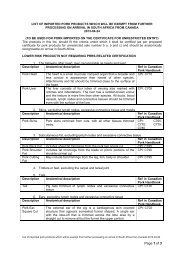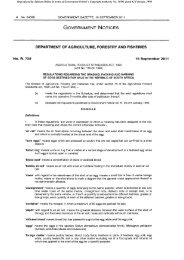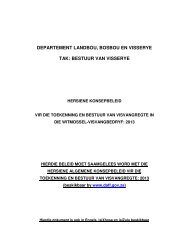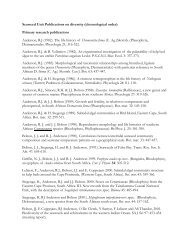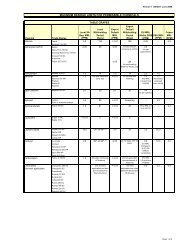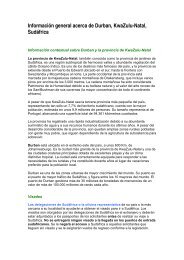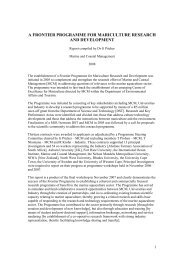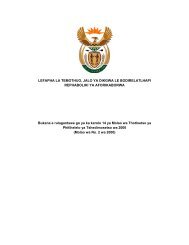You also want an ePaper? Increase the reach of your titles
YUMPU automatically turns print PDFs into web optimized ePapers that Google loves.
tiny<br />
polyps<br />
W<br />
HAT ARE THEY<br />
Corals grow in warm, sunny tropical and<br />
sub-tropical regions, where they exhibit a great<br />
variety of sizes, form, texture and colour. Corals<br />
are basically very simple animals that belong to the<br />
large group or Phylum of invertebrate animals, the<br />
Cnidaria. This group includes jellyfish, sea<br />
anemones and sea fans. These animals all share a<br />
number of common characteristics. They have a<br />
cylindrical, radial body plan, closed at the bottom<br />
and with a mouth surrounded by tentacles at the<br />
top. This 'mouth' serves both for the intake of food<br />
and the expulsion of waste. Surrounding the opening<br />
are tentacles armed with a remarkable defense<br />
system. The tentacles bear hundreds of tiny<br />
stinging cells containing coiled, sharp and often<br />
barbed threads. Most people are aware of the pain a<br />
bluebottle sting elicits, well the other cnidarians also<br />
have stinging cells - just not as potent. Many of<br />
these tiny carnivorous creatures, known as polyps,<br />
make up each coral colony. The corals include a<br />
wide range of different animals but can best be<br />
divided into two basic types, hard and soft corals.<br />
Sea fans form colourful branching colonies.<br />
Hard corals (Order: Scleractinia)<br />
Hard corals are the primary animals responsible for the<br />
formation of the huge structures we call coral reefs. In hard<br />
corals, the outer layer of the body wall secretes lime (calcium<br />
carbonate) which forms a hard casing or cup, known as a<br />
corallite around the animal. This cup supports and protects<br />
hard skeleton<br />
Staghorn coral Cup coral<br />
C O A S TA L A N D M A R I N E L I F E – A N I M A L S : I N V E RT E B R A T E S – C N I D A R I A N S<br />
Corals 3B<br />
the soft body. A few corals are solitary or form small clusters,<br />
however, most corals are colonial and secrete a massive<br />
limestone skeleton. The bulk of these corals is actually non-<br />
living limestone covered by a thin veneer of living tissue. Each<br />
polyp is usually sunken into a cup in the limestone. In hard<br />
coral colonies individual polyps live together in a permanent<br />
association, which enables each to survive. Rather like the<br />
residents in a block of flats pooling their efforts for their<br />
common good. Each individual polyp usually has six or<br />
multiples of six tentacles and a thin layer of fleshy tissue<br />
covers the skeleton connecting the bodies to each other. Hard<br />
corals generally feed at night when the microscopic floating<br />
animals (zooplankton) are most abundant. During the day<br />
their tentacles are retracted into the safety of their corallite.<br />
Hard corals occur in a wide diversity of growth forms such as<br />
branches, plates, domes, sheets and leaves.<br />
Living together<br />
One of the most fascinating aspects of coral growth is their<br />
unique relationship with single-celled algae known as zooxan-<br />
thellae. Within the tissues of reef building corals, and a large<br />
number of other cnidarians, are millions of these algae cells.<br />
These zooxanthellae, safely protected inside the tissues of the<br />
animals, are able to photosynthesise, using the energy from the<br />
sun to convert carbon dioxide and water into food and oxygen.<br />
The corals benefit from the oxygen and food produced by the<br />
algae. The algae gain protection and can use the carbon dioxide<br />
and nitrogenous wastes produced by the coral. Because the<br />
algae remove excess carbon dioxide, the coral polyps can<br />
deposit their limestone skeletons more rapidly. It is amazing to<br />
think that this relationship between a tiny alga and a primitive<br />
animal has enabled the growth of the Great Barrier Reef off<br />
Australia - one of the largest structures built on earth by a life<br />
form and spreading for thousands of kilometres.<br />
Feeding<br />
In addition to the food obtained from the algae, corals also<br />
p rey upon the tiny zooplankton found floating in the water.<br />
The carnivorous corals capture their floating prey<br />
with their tentacles and pass the food into the<br />
"mouth" opening and down to the stomach,<br />
where it is rapidly digested.<br />
Reproduction<br />
Reproduction in the corals can occur either<br />
sexually or asexually. During asexual repro-<br />
duction, budding off from the parent animal<br />
forms new individuals. Sexual reproduction<br />
occurs through the production of eggs and sperm,





